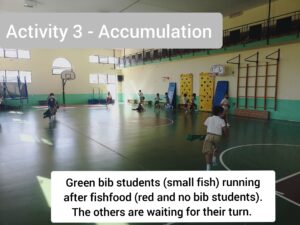BeMED 7. Accumulation
Title |
AccumulationActivity 3 of 3 about plastic pollution |
|
Author |
Saviour Bonnici |
|
Age Guide |
Year 4-8 |
|
Subject Area |
Physical Education |
|
| Preparation Time | 3 minutes | |
| Estimated Duration | 30 to 45 minutes | |
| Site | Gym/ Yard / Outdoor space | |
| No. of participants | Whole class | |
| Educational objectives | This is a fun physical education activity with the aim of teaching students about micro-plastics and our impact on the sea, fish life and our health. This activity provides a realistic and practical example of how micro-plastic accumulates in the food web. | |
| Learning Outcomes | – Speed. Agility. Stamina. Quick reactions.
– I understand that I am responsible for my actions and am capable of anticipating the problems of consuming plastic and adapt to reduce it. |
|
| Link to SDGs
|
SDG 12: Responsible consumption
SDG 14: Life below water SDG 15: Life on Land |
|
| Remote preparation | Playing ‘Uncontrollable’ (Lesson plan 5) and ‘Plastic Breakdown’ (Lesson plan 6) before this activity will prepare students for this activity, however this is optional. | |
| Equipment needed | Three types of coloured bibs
· 6 green bibs · 4 yellow bibs · the rest (according to number of participants) red bibs Internet connection is needed to watch the video links provided in the background information. |
|
| Method | Objective: Catch your food
Student Organization: Small Fish (S) – 6 students wearing green bib (or any other colour) Medium Fish (M) – 4 students wearing yellow bib Top Predator Fish (P) – 2 students Fish Food (F) / Plankton – The majority of the remaining students wearing a red bib (FR). It is VERY IMPORTANT to leave only a few without bibs (F).
Playing the Game
Part 1: Fish food is eaten by small fish · The playing area represents the Ocean · The fish food run in the Ocean · Instruct the small fish to go and eat (catch) all the fish food. · For now, the other fish are waiting. · Whenever a fish food is caught, he/she is transported to a designated captured area where they will remain. Everyone keeps a record of how many fish food they captured. Game is paused when all fish food is caught.
Part 2: Small fish eaten by Medium fish Medium Fish introduced. Now the small fish will be eaten by the medium fish and transported to the captured area. Part 3: Medium fish eaten by the Top Predator fish Top Predator Fish introduced. Same as part 2 and the game ends here. Part 4: Explanation See Recap section below |
|
| Recap
|
The reason for the fish food with the red bib (FR) is now revealed. They are the micro-plastic. The others are the actual fish food (F). The small fish do not know the difference so when they eat, micro-plastics enter the food web. The higher the food web hierarchy, the more micro-plastic accumulation. Apart from killing marine life, when we humans eat fish especially the top fish, we inevitably also ingest the micro-plastics.
Actions students can take: · When encountering plastic rubbish, try to dispose of it properly, if this is safe to do so. · Refuse unnecessary plastic |
|
| Follow-up activities | This is the last of 3 activities, the previous being ‘Uncontrollable’ and ‘Accumulation’, covering the plastic pollution topic which integrates PE and ESD subjects. | |
| Background information for educators | Video link to understand the science behind micro-plastic accumulation:
How Much Plastic Do You Eat? #OurBluePlanet | Earth Lab https://www.youtube.com/watch?v=veMdowmPSbw Video clip from ‘BluePlanet 2’ documentary showing the effects of micro-plastics on marine life: |






